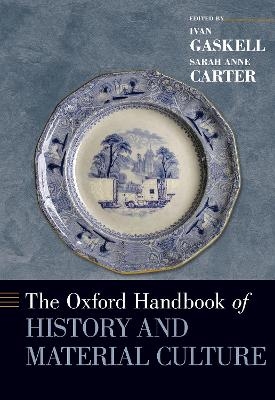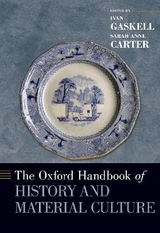The Oxford Handbook of History and Material Culture
Oxford University Press Inc (Verlag)
978-0-19-934176-4 (ISBN)
Ivan Gaskell is Professor of Cultural History and Museum Studies at Bard Graduate Center in New York City. Sarah Anne Carter is Visiting Executive Director of the Center for Design and Material Culture and Visiting Assistant Professor of Design Studies at the University of Wisconsin-Madison
Introduction: Why History and Material Culture? by Ivan Gaskell and Sarah Anne Carter
Part 1
History, Material Culture, and Cognition
Chapter 1: Words or Things in American History? by Steven Conn
Chapter 2: Artifacts and their Functions, by A.W. Eaton
Chapter 3: Mastery, Artifice, and the Natural Order: A Jewel from the Early Modern Pearl Industry, by Mónica Domínguez Torres
Chapter 4: Food and Cognition: Henry Norwood's A Voyage to Virginia, by Bernard L. Herman
Chapter 5: On Pins and Needles: Straight Pins, Safety Pins, and Spectacularity, by Amber Jamilla Musser
Chapter 6: Mind, Time, and Material Engagement, by Lambros Malafouris and Chris Gosden
Part 2
History, Material Culture, and Technology
Chapter 7: Material Time, by John Robb
Chapter 8: Remaking the Kitchen, 1800-1850, by J. Ritchie Garrison
Chapter 9: Boston Electric: Science by "Mail Order" and Bricolage at Colonial Harvard, by Sara J. Schechner
Chapter 10: Making Knowledge Claims in the Eighteenth-Century British Museum, by Ivan Gaskell
Chapter 11: The Ever-Changing Technology and Significance of Silk on the Silk Road, by Zhao Feng
Chapter 12: Science, Play, and the Material Culture of Twentieth-Century American Boyhood, by Rebecca Onion
Part 3
History, Material Culture, and the Symbolic
Chapter 13: The Sensory Web of Vision: Enchantment and Agency in Religious Material Culture, by David Morgan
Chapter 14: Sensiotics, or the Study of the Senses in Material Culture and History in Africa and Beyond, by Henry John Drewal
Chapter 15: The Numinous Body and the Symbolism of Human Remains, by Christopher Allison
Chapter 16: Symbolic Things and Social Performance: Christmas Nativity Scenes in Late Nineteenth-Century Santiago de Chile, by Olaya Sanfuentes
Chapter 17: Heritage Religion and the Mormons, by Colleen McDannell
Chapter 18: From Confiscation to Collection: The Objects of China's Cultural Revolution, by Denise Y. Ho
Part 4
History, Material Culture, and Social Distinction
Chapter 19: Persons and Things in Marseille and Lucca, 1300-1450, by Daniel Lord Smail
Chapter 20: Cloth and the Rituals of Encounter in La Florida: Weaving and Unraveling the Code, by Laura Johnson
Chapter 21: Street "Luxuries": Food Hawking in Early Modern Rome, by Melissa Calaresu
Chapter 22: Ebony and Ivory: Pianos, People, Property, and Freedom on the Plantation, 1861-1870, by Dana E. Byrd
Chapter 23: The Material Culture of Furniture Production in the British Colonies, by Edward S. Cooke, Jr.
Chapter 24: Material Culture, Museums and the Creation of Multiple Meanings, by Neil G. W. Curtis
Part 5
History, Material Culture, and Memory
Chapter 25: Chronology and Time: Northern European Coastal Settlements and Societies, c. 500-1050, by Christopher Loveluck
Chapter 26: Materialities in the Making of World Histories: South Asia and the South Pacific, by Sujit Sivasundaram
Chapter 27: Mapping History in Clay and Skin: Strategies for Remembrance among Ga'anda of Northeastern Nigeria, by Marla C. Berns
Chapter 28: Remember Me: Sensibility and the Sacred in Early Mormonism, by Laurel Thatcher Ulrich
Chapter 29: Housing History: The Colonial Revival as Consumer Culture, by Thomas Denenberg
Chapter 30: Collecting as Historical Practice and the Conundrum of the Unmoored Object, by Catherine Whalen
Conclusion: The Meaning of Things, by Peter Burke
| Erscheinungsdatum | 30.04.2020 |
|---|---|
| Reihe/Serie | Oxford Handbooks |
| Verlagsort | New York |
| Sprache | englisch |
| Maße | 249 x 180 mm |
| Gewicht | 1338 g |
| Themenwelt | Kunst / Musik / Theater ► Kunstgeschichte / Kunststile |
| Geisteswissenschaften ► Archäologie | |
| Geschichte ► Teilgebiete der Geschichte ► Kulturgeschichte | |
| ISBN-10 | 0-19-934176-1 / 0199341761 |
| ISBN-13 | 978-0-19-934176-4 / 9780199341764 |
| Zustand | Neuware |
| Haben Sie eine Frage zum Produkt? |
aus dem Bereich




